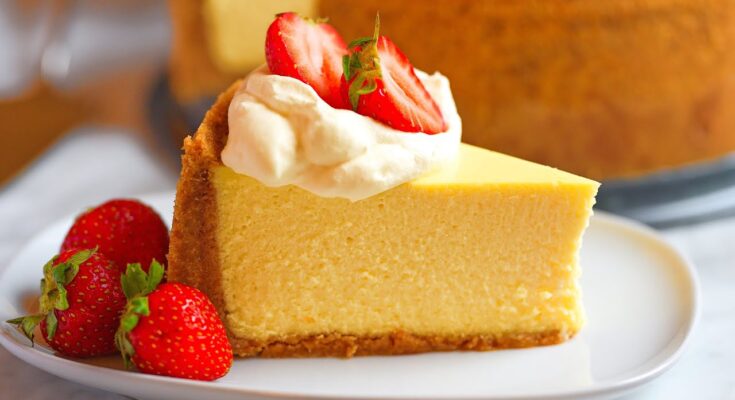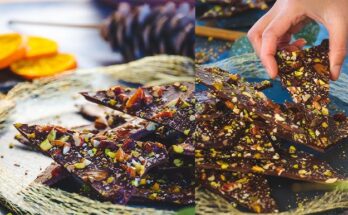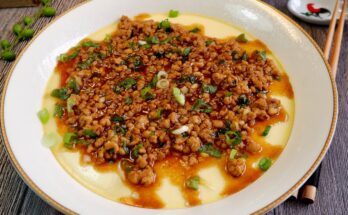Cheese Cake Recipe: Ah, cheesecake! This dessert is a global favorite, loved for its rich, creamy texture and versatility. Did you know that cheesecake dates back to ancient Greece? Over the centuries, it has evolved into countless varieties, from classic New York style to fruity or chocolate-infused versions. While store-bought options are convenient, there’s nothing like a homemade cheesecake crafted with love and the freshest ingredients.
Making cheesecake at home may seem intimidating, but it’s surprisingly straightforward with the right guidance. This step-by-step guide will walk you through creating a delicious cheesecake that’s sure to impress your family and friends.
Ingredients Required
Main Ingredients
- Crust:
- 1 ½ cups of graham cracker crumbs (or your choice of biscuit crumbs)
- 5 tablespoons of unsalted butter (melted)
- 2 tablespoons of granulated sugar
- Filling:
- 24 oz (680 g) of cream cheese (softened)
- 1 cup of granulated sugar
- 3 large eggs
- 1 cup of sour cream
- 2 teaspoons of vanilla extract
- 1 tablespoon of all-purpose flour (optional for texture)
Optional Ingredients for Flavor Variations
- Lemon zest or juice for a citrus twist
- Melted chocolate for a chocolate cheesecake
- Fresh fruit or fruit puree for a fruity variation
Tips on Ingredient Quality
Always opt for high-quality ingredients. Full-fat cream cheese ensures a rich filling, and fresh eggs and real vanilla extract elevate the flavor. If using pre-made crusts, choose brands with minimal additives.
Tools and Equipment
Essential Tools
- Springform pan (9-inch is standard)
- Mixing bowls
- Hand mixer or stand mixer
- Measuring cups and spoons
- Rubber spatula
Recommendations for Beginners
If you’re new to baking, invest in a springform pan—it’s a game-changer for easily removing the cheesecake. A hand mixer works just as well as a stand mixer for blending ingredients.
Optional Tools
- Food processor for blending crust ingredients
- Offset spatula for smooth filling
- Kitchen thermometer to check doneness
Preparing the Crust
Types of Crusts
The classic graham cracker crust is a fan favorite, but you can also experiment with Oreos, digestive biscuits, or gingersnaps for added flavor.
Step-by-Step Crust Preparation
- Crush the graham crackers into fine crumbs using a food processor or a rolling pin.
- Combine crumbs, melted butter, and sugar in a bowl. Mix until the texture resembles wet sand.
- Press the mixture evenly into the bottom of a greased springform pan. Use the back of a spoon to compact it firmly.
- Pre-bake the crust at 350°F (175°C) for 10 minutes to set it, then let it cool completely.
Tips for Achieving the Perfect Crust
- Ensure the crust mixture is compacted well to prevent crumbling.
- Use parchment paper at the bottom of the pan for easier removal.
Making the Cheesecake Filling
Key Steps for Creamy Cheesecake Filling
- Beat the softened cream cheese until smooth and lump-free.
- Add sugar and continue mixing until fully combined.
- Incorporate eggs one at a time, mixing on low speed to avoid over-aeration.
- Blend in sour cream, vanilla extract, and optional flour for a silky texture.
Tips for Avoiding Cracks and Lumps
- Bring all ingredients to room temperature before mixing.
- Avoid overmixing to prevent excess air in the batter, which can cause cracks during baking.
Variations for Flavored Cheesecake
- For a chocolate cheesecake, add melted chocolate to the batter.
- Swirl in fruit puree for a marbled effect.
- Add spices like cinnamon or nutmeg for a seasonal twist.
Assembling the Cheesecake
How to Layer the Crust and Filling
- Ensure the pre-baked crust is completely cool before adding the filling.
- Pour the prepared cheesecake filling onto the crust, spreading it evenly with a rubber spatula.
- Tap the pan gently on the counter to release any trapped air bubbles.
Ensuring Even Distribution
Rotate the pan as you spread the filling to ensure even thickness. This prevents uneven baking, which can lead to cracks or sinking in certain spots.
Preparing for Baking
Cover the bottom and sides of the springform pan with aluminum foil if you’re using a water bath method. This keeps water from seeping into the cheesecake during baking.
Baking the Cheesecake
Choosing the Right Baking Technique
The baking process is crucial to achieving a creamy, crack-free cheesecake. You can choose between:
- Traditional baking: Bake the cheesecake directly on the oven rack.
- Water bath (bain-marie): Place the springform pan in a larger pan filled with hot water.
Water Bath Method vs. Regular Baking
- Water bath: Creates steam in the oven, ensuring even heat distribution and preventing cracks.
- Regular baking: Works well if you take care to avoid overbaking and use proper cooling techniques.
Troubleshooting Common Baking Problems
- If the cheesecake cracks: Don’t worry—it can be covered with toppings!
- If the edges bake too quickly: Cover with aluminum foil during the last 10–15 minutes of baking.
- Check doneness: The edges should look set, but the center should still have a slight jiggle.
Cooling and Setting the Cheesecake
Why Proper Cooling Is Essential
Cooling gradually prevents cracks and ensures the cheesecake sets properly. Sudden temperature changes can ruin the texture.
How to Avoid Cracks During Cooling
- Turn off the oven and leave the cheesecake inside with the door slightly ajar for about an hour.
- Transfer the pan to a wire rack and cool to room temperature before refrigerating.
Setting Time Recommendations
Refrigerate the cheesecake for at least 4–6 hours, or overnight if possible. This allows the flavors to meld and the texture to firm up.
Decorating the Cheesecake
Ideas for Toppings and Garnishes
- Classic fruit toppings: Fresh berries, sliced fruits, or fruit compote.
- Indulgent options: Chocolate ganache, caramel drizzle, or crushed candy bars.
- Elegant finishes: Dust with powdered sugar or garnish with edible flowers.
Seasonal and Festive Decorating Tips
- For the holidays, use cranberry sauce and white chocolate.
- During summer, fresh mango slices or lemon curd work beautifully.
- For birthdays, add sprinkles or piped whipped cream.
Making It Instagram-Worthy
Create symmetry in your toppings and use contrasting colors for visual appeal. A simple swirl of caramel or chocolate can add a professional touch.
Serving Suggestions
Perfect Pairings: Drinks and Accompaniments
- Pair cheesecake with a cup of coffee, tea, or dessert wine for a sophisticated treat.
- Serve with a dollop of whipped cream or a scoop of vanilla ice cream for extra indulgence.
Best Practices for Slicing and Serving
- Use a sharp knife dipped in hot water for clean slices.
- Wipe the knife with a damp cloth between cuts to prevent smudging.
- Serve chilled for the best texture and flavor.
Storing Leftovers
Wrap slices individually in plastic wrap or store in an airtight container. Cheesecake keeps well in the refrigerator for up to 5 days or in the freezer for up to 3 months.
Cheesecake Variations
Classic New York-Style Cheesecake
This iconic recipe uses cream cheese, heavy cream, and a touch of lemon for a dense yet creamy dessert.
Chocolate, Berry, and Citrus Cheesecakes
- Chocolate: Add melted dark chocolate and top with chocolate shavings.
- Berry: Mix in pureed strawberries or raspberries for a fruity twist.
- Citrus: Incorporate lemon or lime zest for a refreshing flavor.
No-Bake Cheesecake Recipe
For a simpler option, skip the oven! Use cream cheese, whipped cream, and gelatin for a light, mousse-like texture.
Common Mistakes to Avoid
Cracks in the Cheesecake
- Prevent by using a water bath or cooling gradually.
- Don’t overbake; the center should still have a slight jiggle when done.
Overmixing or Undermixing
- Overmixing incorporates too much air, leading to cracks.
- Undermixing can leave lumps in the filling, affecting texture.
Improper Baking Temperature
- Always preheat the oven and use an oven thermometer to ensure accuracy.
Tips for Success
Importance of Room Temperature Ingredients
Softened cream cheese blends more easily, reducing the risk of lumps.
Preheating the Oven
Ensures even baking from the start, preventing undercooked centers or burnt edges.
Time Management for a Seamless Process
Prepare the crust while ingredients for the filling come to room temperature. This saves time and ensures a smoother workflow.
FAQs about Cheesecake Recipe
What type of cheese should I use for making cheesecake?
For classic cheesecake, cream cheese is the most commonly used base. It provides a rich, creamy texture and mild flavor that complements both sweet and tangy toppings. For variations, you might also consider ricotta or mascarpone for a lighter texture or a more distinct flavor.
How do I prevent my cheesecake from cracking?
To prevent cracks, avoid overmixing the batter, which can introduce too much air. Also, ensure that your cheesecake cooks gently by using a water bath. Let the cheesecake cool gradually in the oven with the door slightly open to minimize temperature shocks.
Can I make cheesecake without a springform pan?
Yes, you can use a regular cake pan for cheesecake; just line it with parchment paper for easy removal. Alternatively, mini cheesecakes can be made in muffin tins with cupcake liners.
Is it necessary to use a water bath?
While not strictly necessary, a water bath helps to evenly distribute heat and maintain a moist environment in the oven, reducing the likelihood of cracking and overcooking. It’s especially useful for achieving a smooth, creamy texture.
How long does cheesecake last in the fridge?
Properly stored in an airtight container, cheesecake can last up to 5 days in the refrigerator. Ensure it’s cooled completely before covering to prevent condensation.
Can cheesecake be frozen?
Yes, cheesecake freezes very well. Wrap it tightly in plastic wrap and then in aluminum foil. It can be stored in the freezer for up to 3 months. Thaw in the refrigerator overnight before serving.
What are some popular toppings for cheesecake?
Popular toppings include fresh fruits like strawberries or blueberries, fruit sauces, chocolate ganache, caramel sauce, and whipped cream. You can customize your toppings based on personal preference or seasonal availability.
Conclusion
Homemade cheesecake may take a little time and effort, but the results are worth every second. By following this step-by-step guide, you’ll create a creamy, indulgent dessert that rivals anything from a bakery. Whether you stick to the classic recipe or experiment with flavors, your cheesecake will be a showstopper at any gathering. So roll up your sleeves and get baking—you’ve got this!



